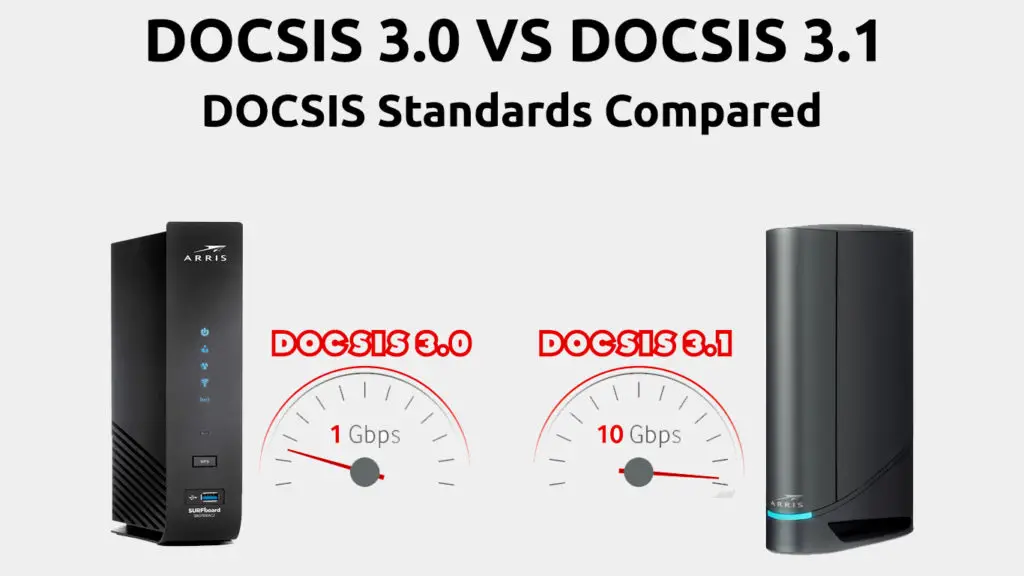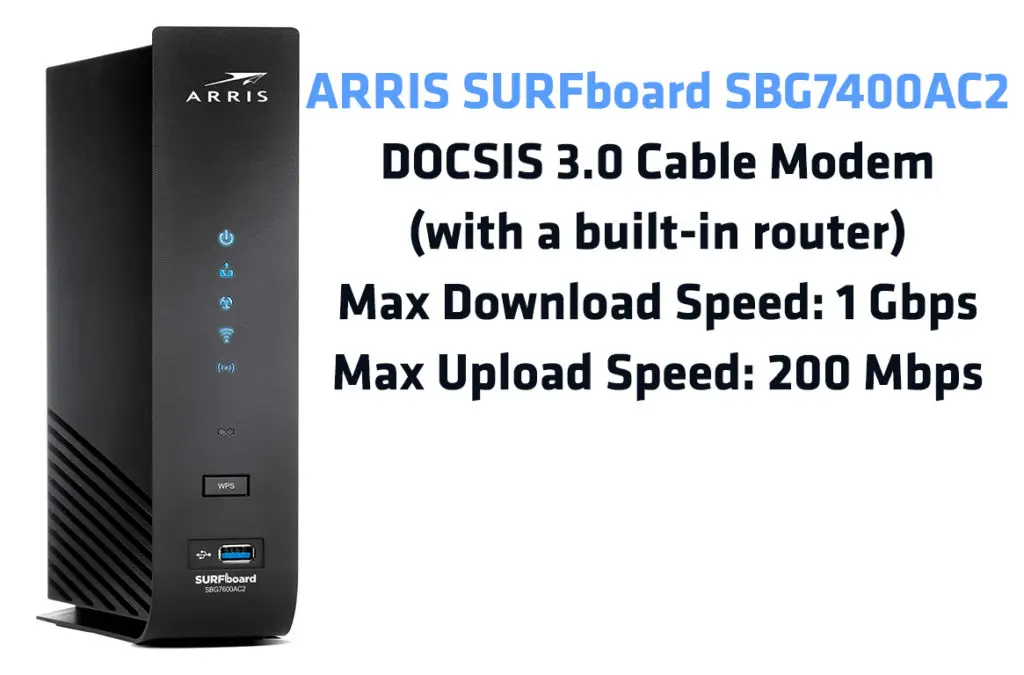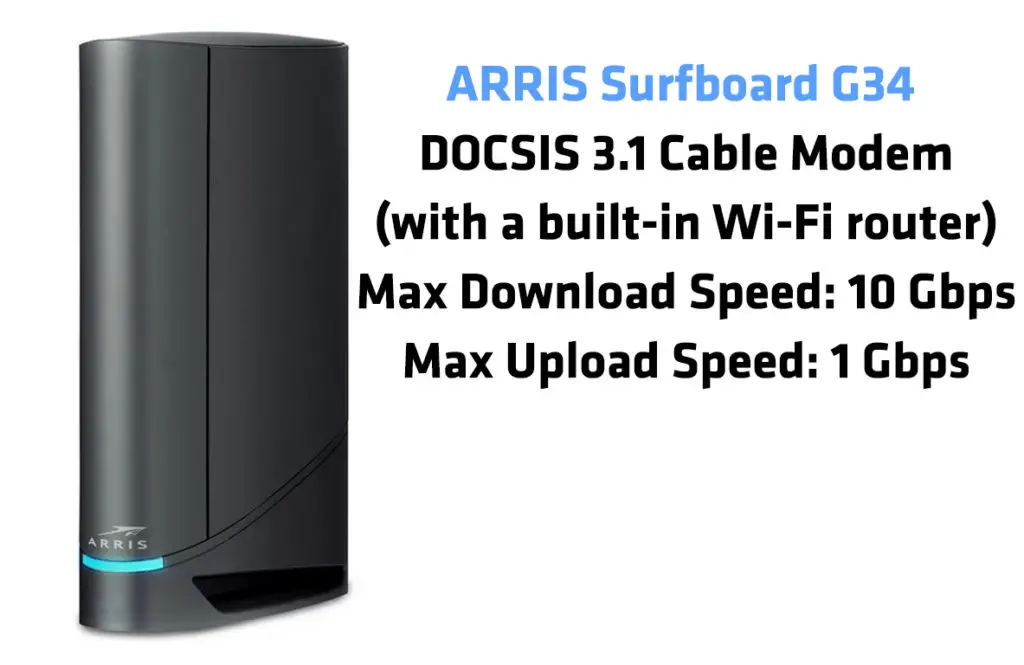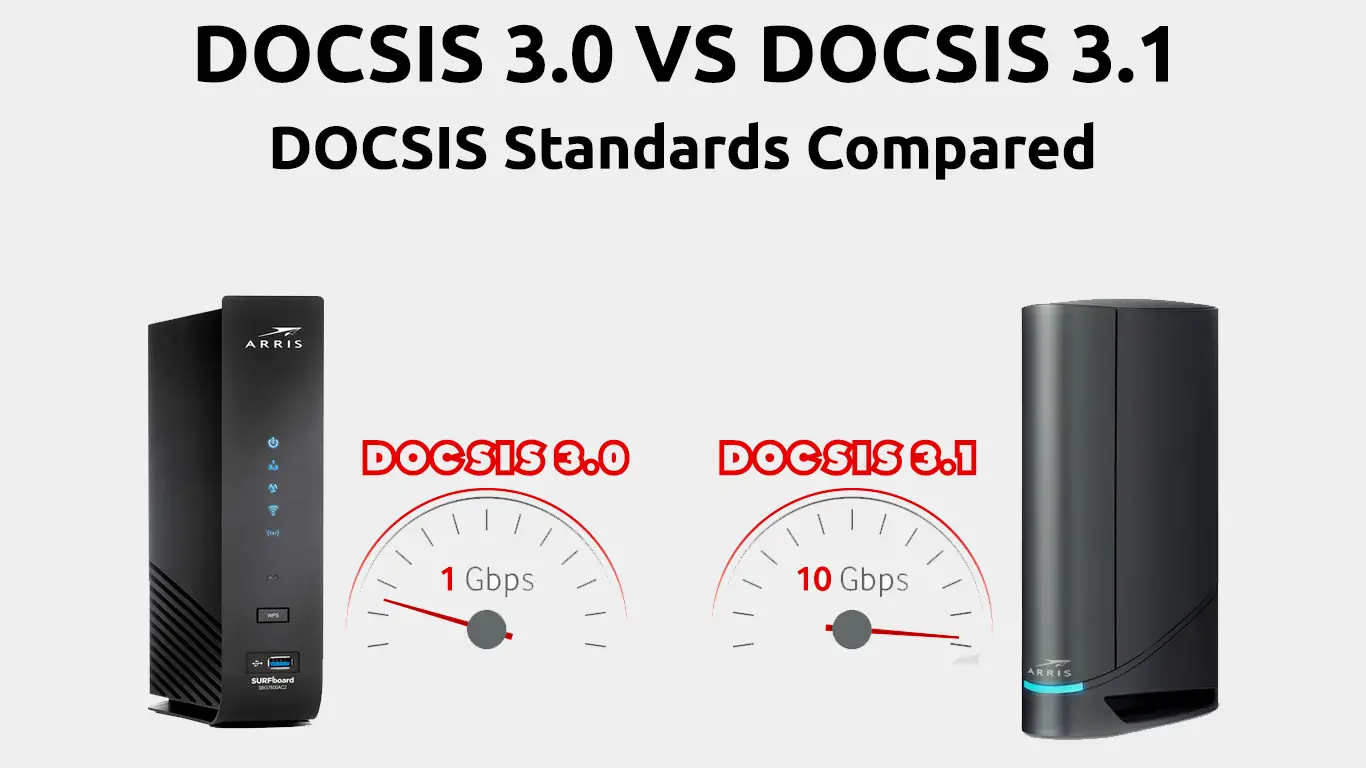Cable internet is among the fastest connections. It runs through underground coaxial cables and is an ideal option for uploading large files, online gaming, video calls, and streaming.
If you have cable internet in your home or office, you’ve probably heard or seen the terms DOCSIS 3.0 and DOCSIS 3.1 at some point.

DOCSIS stands for Data Over Cable Service Interface Specification. It refers to the international telecommunications standard or specification that dictates how cable modems work.
The standard facilitates data transmission over coaxial cables. It determines how a cable modem receives data from your ISP before transmitting it to your router.
DOCSIS has different versions ranging from DOCSIS 1.0 to DOCSIS 4.0. This post compares DOCSIS 3.0 and DOCSIS 3.1, the most used cable modem specifications. Keep reading to find out which cable modem is ideal for your internet needs.
DOCSIS Explained
CONTENTS
What is a Cable Modem?
A cable modem is a network bridge that communicates with your internet service provider over a coaxial cable. This hardware device connects your computer, Smart TV, and other gadgets to your cable company’s internet service.
Most cable companies not only provide television programs and phone services but also diversify by offering internet access to their consumers via radio frequency signals transmitted over underground coaxial or fiber-optic cables.
You require a cable modem to access the internet services provided by your cable company. It essentially connects your router to your ISP, ensuring that all compatible and authorized devices connect to the internet accordingly.
Note: You do not need a cable modem if you have access to a fiber internet connection. Instead, you need an optical network terminal (ONT) to connect to the web.
What is DOCSIS 3.0?
DOCSIS 3.0 is a cable modem standard released in 2006 to replace the DOCSIS 2.0 version. This modem specification was renowned for its high-speed capabilities over its predecessor as it supports maximum download speeds of up to 1 Gbps. At the same time, the former has a capacity of only 40 Mbps.
That’s not all. DOCSIS 3.0 supports maximum upstream speeds of 200 Mbps compared to its predecessor, which has a capacity of only 30 Mbps. With DOCSIS 3.0 came support for IPv6, an Internet Protocol that identifies devices and facilitates communication over an internet network.

Ever since the inception of DOCSIS 3.0, on-demand TV and online gaming have become a reality, thanks to the significantly enhanced downstream and upstream capacities.
With DOCSIS 3.0, you can watch movies in 4k and stream your favorite sports programs without lagging or buffering issues. The data rates are more than sufficient for day-to-day activities on the web.
What is DOCSIS 3.1?
DOCSIS 3.1 is one of the latest cable modem versions released in 2013 and is a significant upgrade of the DOCSIS 3.0 standard. This modem generation is renowned for its greater capacity and higher speeds than all previous versions. DOCSIS 3.1 modems support a maximum download capacity of 10 Gbps and 1 Gbps upstream speeds.

The DOCSIS 3.1 version has 50% more data throughput than any other previous standards. Besides, it has lower latency, thanks to its active queue management system, ensuring faster connections and better user experiences. The modem is the perfect match for online gaming as it can handle data packets with higher efficiency.
DOCSIS 3.1 modems are ideal for gigabit internet connections since they have restructured channel specifications with 8 upstream and 32 downstream channels for higher stability. The best part is that they are 100 percent backward compatible with DOCSIS 3.0 connections.
The only issue is that DOCSIS 3.1 modems are pricey, but this is not a concern since they offer good value for your money.
DOCSIS 3.1 Explained
What Are the Differences Between DOCSIS 3.0 and 3.1?
DOCSIS 3.0 and 3.1 have significant differences in speed, performance, latency, and efficiency. Understanding these differences can help you decide which modem to pick for your internet and networking needs.
Here is a breakdown of the differences between DOCSIS 3.0 and 3.1:
- Download and Upload Speeds
The downstream and upstream capacities of the DOCSIS 3.0 and DOCSIS 3.1 are incomparable. While the DOCSIS 3.0 supports download speeds of up to 1 Gbps, DOCSIS 3.1 is ten times faster and has a downstream capacity of 10 Gbps.
Upstream capacities are similarly different. The DOCSIS 3.0 supports upload speeds of up to 200 Mbps, while the DOCSIS 3.1 has a maximum upstream capacity of 1Gbps. The latest models of these cable modems can support upload speeds of up to 2 Gbps.
- Average Latency
Latency refers to the time delay during data transmission. It essentially factors in the time it takes to transfer data over a wired or wireless network from one point to the next. High latency often results in poor performance, while low latency ensures your connection is fast and buffer-free.
The DOCSIS 3.0 has an average latency of 50 milliseconds, while the DOCSIS 3.1 has a low latency of 10 milliseconds. When comparing the two, you can tell that DOCSIS 3.1 is more efficient. It uses a feature called Active Queue Management to help decrease latency.
- Channel Bonding
Cable modems have multiple downstream and upstream channels. Bonding is when these channels combine to increase the data traffic the modem can comfortably support.
The DOCSIS 3.0 and 3.1 support channel bonding, with the former available in 8*4, 16*8, 24*8, and 32*8, while the latter is available in 32*8. 8*4 means the modem has 8 downstream channels and 4 upstream channels. The higher the channels, the better the traffic amount it can handle.
Channel Bonding Explained
- Data Throughput
Data throughput refers to the rate of data between different networking devices, depending on the service accessed, number of users, MAC layer efficiency, and bottleneck speed. For instance, the data throughput for online gaming and watching 4K videos is 50 to 100 Mbps download stream.
The DOCSIS 3.0 standard has a maximum data throughput of 256-QAM, while the DOCSIS 3.1 version has 4096-QAM, 50% more than other versions.
- Security Features
Online security is essential in this digital era. Fortunately, both DOCSIS 3.0 and DOCSIS 3.1 have built-in security features such as malware protection and data encryption. However, the DOCSIS 3.1 modem security mechanisms are superior to what the DOCSIS 3.0 version can offer.
- Long-Term Use
Even though the DOCSIS 3.0 cable modem has been around for a while, it will soon become obsolete as newer versions pop up. DOCSIS 3.1 is not the latest version since we have the DOCSIS 4.0 standard, which was released in 2017. However, DOCSIS 3.1 remains the ideal choice for now for future-proofing your cable internet connection.
DOCSIS 4.0 – The Future of Cable Internet
What Are the Pros of DOCSIS 3.0?
The DOCSIS 3.0 cable modem standard has several benefits over previous versions. The most notable advantages include:
- Enhanced Downstream/Upstream Capacity
The DOCSIS 3.0 cable modem came with greater capacity over other previous versions. The modem could support downstream speeds of 1 Gbps and upstream speeds of 200 Mbps for improved data rates. With such remarkable speeds and enhanced capacity, online gaming and live streaming became a reality.
- Compatible with most ISP Plans
Many cable companies and ISPs offer internet plans that don’t exceed speeds of 1 Gbps. For this reason, the DOCSIS 3.0 is a better choice for most consumers since it is compatible with these data rates and internet connection plans. Besides, DOCSIS 3.0 modems have multiple channels to support everyday internet activities without any concerns.
- Supports Channel Bonding
The emergence of the DOCSIS 3.0 brought about channel bonding. As mentioned earlier, channel bonding is when multiple channels combine to increase the data traffic the modem can comfortably support.
DOCSIS 3.0 modems have 32 downstream and 8 upstream channels. When combined through channel bonding, it results in faster and more stable internet connections.
- Readily Available
Even with the emergence of the DOCSIS 3.1 and DOCSIS 4.0 versions, DOCSIS 3.0 cable modems are still in use today and are readily available. Besides, they are cheaper, making them easy to dispose of if you want to upgrade to a high-speed cable modem.
What Are the Cons of DOCSIS 3.0?
While DOCSIS 3.0 is renowned for its robust speeds and efficient performance, it has its fair share of downsides. These include:
- Incompatible with Gigabit Connections
Even though DOCSIS 3.0 version supports high data rates and has a download speed of 1 Gbps, it is not compatible with Gigabit plans. If you want to enjoy faster speeds, consider upgrading to DOCSIS 3.1.
- Higher Latency
Latency refers to the time it takes to transmit data packets over a network from one point to another. DOCSIS 3.0 has a latency of 50 milliseconds. Although this is lower than its predecessor DOCSIS 2.0, it is higher than DOCSIS 3.1, meaning you might experience lagging and buffering issues.
- Not future proof
DOCSIS 3.0 cable modems are inexpensive and widely available. However, this doesn’t mean they are future-proof. With the emergence of the DOCSIS 3.1 and DOCSIS 4.0 versions and rapid technological developments, it’s just a matter of time before they become obsolete.
What Are the Pros of DOCSIS 3.1?
The DOCSIS 3.1 is the most common cable standard used today because of its superiority, low latency, efficiency, breathtaking speeds, and remarkable performance. Here are some reasons you should choose DOCSIS 3.1 over other versions:
- Incredible Speeds
DOCSIS 3.1 cable modems are 10x faster than DOCSIS 3.0 modems. They support maximum download speeds of 10 Gbps and upload speeds ranging from 1-2 Gbps, making them the ideal option for Gigabit internet plans. Thanks to these remarkable speeds, you can live stream, video call, play online games, and watch 4K and HD movies seamlessly.
- Lower Latency
DOCSIS 3.1 modems use an active queue management system to determine how data packets transit over the network from one point to another. This feature ensures a decrease in latency, maintaining it at 10 milliseconds. This modem specification also uses Low-Density Parity Check (LDPC) error correction to ensure seamless data transmission.
- Backward Compatibility
Another significant advantage of DOCSIS 3.1 modems is that they are compatible with all devices that use previous cable modem versions. The modem is compatible with older equipment and previous software versions, so you shouldn’t have an issue if you use an old PC or an almost outdated OS.
- Enhanced Security Features
As hacking cases escalate, online security has become more critical than ever. Fortunately, DOCSIS 3.1 cable modems have built-in security features to help keep hackers at bay and protect your network from cyberattacks. The latest modems have malware protection and data encryption features for a secure connection.
- Energy Efficient
Cable modems require a small amount of power to operate. As much as the power consumption is unnoticeable, it makes economic sense to purchase an energy-efficient modem. DOCSIS 3.1 modems are among the most energy-efficient options in the market. They support light sleep modes that automatically deactivate the modem when idle, reducing overall power consumption.
- Future Proof
Even with the emergence of the DOCSIS 4.0, the DOCSIS 3.1 modem remains a popular option if you want to future-proof your internet connection. Many end users are yet to transit to DOCSIS 4.0, making DOCSIS 3.1 an ideal choice for now and the future.
What Are the Cons of DOCSIS 3.1?
The DOCSIS 3.1 cable modem is not immune to deficiencies. It has a few shortcomings such as:
- Pricey
When the DOCSIS 3.1 version first emerged in 2013, it was relatively expensive and out of reach for many people. Thankfully, things have changed, especially with the launch of the DOCSIS 4.0 version in 2017. DOCSIS 3.1 cable modems are now affordable and readily available.
- Can Cause IP Address Conflicts
Most DOCSIS 3.1 cable modems have two Gigabit ports, but this greatly depends on the model of the device. Despite having two ports, you can only use one at a time. Using both ports concurrently can cause IP address conflicts unless you contact your ISP to assign another address to the second port.
Conclusion
If you want to experience fast and robust internet speeds with lower latency and outstanding performance, consider acquiring the DOCSIS 3.1 cable modem. Even though DOCSIS 4.0 is already available, this standard offers downstream speeds of up to 10 Gbps, placing it at par with its successor.
Moreover, it has enhanced online security features and is highly energy-efficient. With all these benefits to consider, there is no reason to choose another cable modem other than DOCSIS 3.1.

Hey, I’m Jeremy Clifford. I hold a bachelor’s degree in information systems, and I’m a certified network specialist. I worked for several internet providers in LA, San Francisco, Sacramento, and Seattle over the past 21 years.
I worked as a customer service operator, field technician, network engineer, and network specialist. During my career in networking, I’ve come across numerous modems, gateways, routers, and other networking hardware. I’ve installed network equipment, fixed it, designed and administrated networks, etc.
Networking is my passion, and I’m eager to share everything I know with you. On this website, you can read my modem and router reviews, as well as various how-to guides designed to help you solve your network problems. I want to liberate you from the fear that most users feel when they have to deal with modem and router settings.
My favorite free-time activities are gaming, movie-watching, and cooking. I also enjoy fishing, although I’m not good at it. What I’m good at is annoying David when we are fishing together. Apparently, you’re not supposed to talk or laugh while fishing – it scares the fishes.

